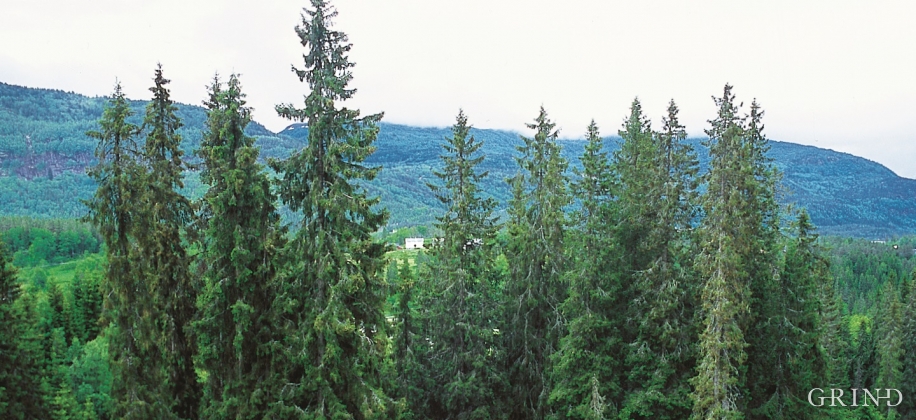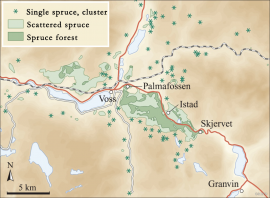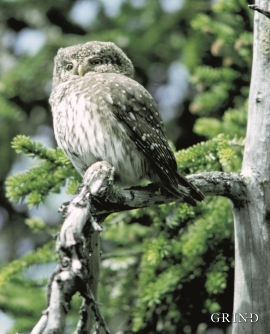Published: 11.08.2015 | Author: Bjørn Moe, Knut Nedkvitne, Stein Byrkjeland
How did the spruce tree get to Voss? Did the seed or small spruce plants get help from people, for example, to make it here unscathed? Nobody knows.
Botanists have asked these questions as long as one has known of the spruce tree. S.C. Sommerfelt cites from his botanical excursion to the Bergen vicinity in 1827: "So strange, that here between Graven and Voss, is the only place in the vicinity of Bergen where spruce grows. That the ocean winds are the reason, there can be no doubt". Sommerfelt nonetheless noted doubtfully, "but why then does spruce grow in the vicinity of Trondheim Fjord, up in Naumdalen, where the winds many places fall just as freely inward from the open sea as in many of Bergen's fjords?"
The natural spruce forest at Voss is known for being the largest in western Norway. Its main area lies between Skjervet and Palmafossen, roughly ten kilometres as the crow flies. Here the spruce grows well on the protected slopes, especially where the land slopes toward the north and north-east. It is not difficult to find tall trees. One of them has been protected for many years. The largest spruce grow at the edge of a stream at Istad, where the trees are over 40 metres high. This is exceptionally high in Norway. The large spruce trees are vulnerable and easily blow over in a strong wind, because their root systems are rather shallow.
The good growth is linked to the nutrient-rich soil overlying the phyllite bedrock. It is therefore on the phyllite that the spruce seed sprouts and spreads best. On the best growing places, there are high perennials and finicky ferns in the vegetation, such as alpine blue-sow-thistle and ostrich fern. Where the conditions are not as good, the spruce forest grows more slowly. At such places the forest floor is usually more nutrient depleted, supporting plants like blueberry, mountain cranberry and some Scottish heather. Two of the more easterly species in the forest are one-flowered wintergreen and the orchid, creeping lady's tresses.
The self-seeded spruce has a short history in Norway after the Ice Age - most of the other native tree sorts have been here much longer. It was Knut Faegri who discovered the age of the Voss spruce in 1949: Pollen analysis showed that the first spruce came to Voss in the 1200s.
Spruce spread originally from Russia toward the west. It reached Finland roughly 5000 years ago, and eastern Norway roughly 2000 years ago. The westward spreading came to a full stop when spruce reached the mountainous area between Eastern and Western Norway yet a thousand years later - with a few exceptions: Seeds that wafted over the mountains from the valleys of eastern Norway or perhaps came over with the help of humans, probably laid the basis for the spruce forest at Voss and other smaller stands of spruce. The seed germinated where there was best chance for it to land, namely, in the transition between forest and high mountains. Several of the small self-seeded spruce forests lie high up toward the mountains, both in Hardanger, in Modalen and in Inner Sogn.
When the spruce spread itself over western Norway it took a long time, since fjords and mountains had to be crossed. In later years spruce has more often been spread by humans - large parts of Western Norway are planted today. The good growth tells us that the coastal climate is not the reason there is so little natural spruce in this part of the country. The explanation is rather that this tree sort has not had much time yet in which to spread.
The spreading of the spruce forest from east to west in Scandinavia. Numbers: years before present. (Ulf Hafsten/Dagfinn Moe/Eva Bjørseth)
Birds from Eastern Norway
Voss is the only place in Hordaland where you can be lucky enough to hear the whistling spring song of the Pygmy Owl. They are not abundant, but if you wait at the edge of the forest in the evening or an early morning in March or April, you might be lucky. The Great Spotted Woodpecker is also a permanent resident at Voss - this is probably because of the natural spruce forest. In the east it is the most common woodpecker, but in western Norway other species are more common. (Roar Solheim)
- Fægri, K. 1949. Studies on the Pleistocene of Western Norway. IV. On the immigration of Picea abies (L.) Karst. Bergen Museum Årbok.
- Nedkvitne, K.; Thomter, H. P. 1953. Forekomstene av naturlig gran innen Voss herad. Tidsskr. for Skogbruk. 61:239–268.






